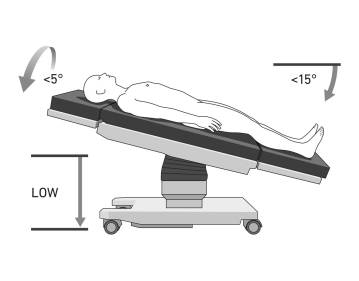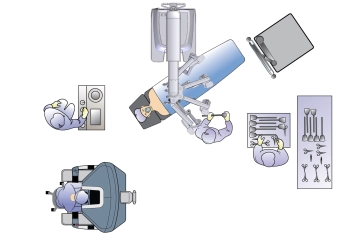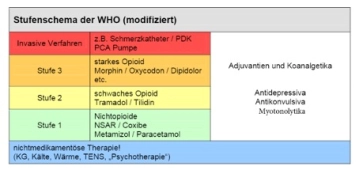- Therapy-resistant GERD
- Complicated GERD, such as: LA grade C/D. Peptic stricture
- GERD not fully controlled with medication
- Patient preference to avoid lifelong use of proton pump inhibitors
- Accompanying hiatal hernia types II to IV
-
Indications
-
Contraindications
Specific Contraindications:
- Esophageal motility disorders, such as: Achalasia. Diffuse esophageal spasm
- Esophageal involvement in autoimmune diseases (e.g., CREST syndrome in scleroderma)
General Contraindications:
General contraindications for robotic surgery align with those for minimally invasive procedures, including:
- Conditions contraindicating pneumoperitoneum, such as:
- Severe systemic diseases
- Extensive abdominal adhesions (hostile abdomen)
Relative Contraindications:
Cases where preoperative optimization may mitigate risks:
- Severe coagulation disorders: Quick < 50 %, PTT > 60 sec, platelets < 50/nL
- Significant portal hypertension with caput medusae
- Severe cardiovascular comorbidities making anesthesia risky (e.g., NYHA class III/IV with critical carotid stenosis)
-
Preoperative Diagnostics
![Preoperative Diagnostics]()
Patient History:
- Typical GERD symptoms
- Long-standing history of reflux
- Positive response to proton pump inhibitors (PPIs)
- Need for increasing PPI dosages, PPI intolerance, or unwillingness to take PPIs
- Reduced quality of life or intolerable reflux symptoms
- Assess patient distress using a quality-of-life index
- Recurrent aspiration episodes
Gastroscopy:
- Always classify reflux esophagitis endoscopically before invasive therapy using the Los Angeles Classification:
- Diagnosis of a potential hiatal hernia.
- The Los Angeles classification is based on the endoscopic evaluation of the esophagus and distinguishes between four subgroups:
- Grade A: One or more mucosal breaks < 0.5 cm, not extending between the tops of two mucosal folds.
- Grade B: At least one mucosal lesion > 0.5 cm but not extending between two folds.
- Grade C: Mucosal lesions involving multiple folds but less than 75 % of the esophageal circumference.
- Grade D: Circumferential mucosal lesions involving more than 75 % of the esophageal circumference.
Impedance-pH Monitoring:
- Perform impedance-pH monitoring preoperatively to confirm pathological reflux
- Discontinue PPIs for 7 days before the test if clinically feasible
- DeMeester score > 14.7 is pathological
- Establish pathological acid exposure with symptom correlation
High-Resolution Esophageal Manometry:
- Mandatory to exclude motility disorders with incomplete antireflux barrier function.
Additional Preoperative Assessments:
- Surgical laboratory tests
- Abdominal ultrasound
- Lung function tests for relevant patient history
- Chest X-ray (2 views): For therapy-relevant questions
- ECG: If indicated
- Contrast swallow (Gastrographin): If necessary
- CT abdomen: In cases of endoscopically identified thoracic stomach
Note: The Montreal Classification should be applied for standardized terminology, diagnosis, and treatment planning in GERD.
-
Preoperative Preparation
Outpatient/Inpatient Preoperative Preparation:
- Hygiene: Shower with antiseptic soap the evening before surgery
- Shaving: From nipples to thighs
- Diet: Full diet until instructed otherwise
- Pre-medication Clinic: Ensure clearance and optimization of any preexisting conditions
- Epidural Catheter (PDK): Not indicated
- Antibiotics: Administer Cefuroxime 1.5 g IV in the operating room
- Thromboprophylaxis:
- Standard: Clexane 40 mg
- Anti-embolism stockings (e.g., compression stockings)
- Breathing exercises: For patients with COPD or large accompanying hiatal hernia
- Anticoagulation Management:
- Aspirin: Perioperative continuation is allowed
- Clopidogrel (ADP inhibitor): Pause at least 5 days preoperatively
- Vitamin K antagonists: Discontinue 7 – 10 days before surgery with INR monitoring and bridge with subcutaneous low-molecular-weight heparin
- NOACs (new oral anticoagulants): Discontinue 2 – 3 days preoperatively
- Consult cardiologist if necessary
Bridging Considerations:
- Vitamin K antagonists: Bridge with short-acting heparins if INR is outside the target range
- NOACs: Bridging is generally unnecessary due to their short half-life. For high thrombotic/embolic risk, bridge with unfractionated heparin (UFH) under inpatient conditions
Preparation in the Operating Room:
- IV Access or Central Venous Catheter (if required): Typically placed during anesthesia induction
- Arterial Line: Place if necessary as part of anesthesia preparation
-
Informed Consent
Discussion Topics:
- Indication: Explain the medical necessity for surgery
- Planned Procedure: Detail the surgical approach and postoperative care
- Treatment Alternatives: Present possible non-surgical or alternative interventions
General Risks:
- Bleeding or rebleeding requiring blood transfusion
- Placement of drainage tubes or urinary catheters
- Conversion to open surgery in the event of complications
- Potential need for surgical revision due to complications
- Intra-abdominal abscess requiring intervention (e.g., drainage or surgery)
- Wound infection
- Trocar hernia
Specific Risks:
- Esophageal or gastric injuries
- Damage to adjacent structures (e.g., spleen, pancreas, small intestine, colon, liver, gallbladder)
- Potential need for extended surgery
- Pneumothorax
- Postoperative dysphagia
- Inability to burp
- Increased retention of gas in the gastrointestinal tract
- Vagus nerve injury
- Denervation syndrome or diarrhea
- Risk of recurrence
-
Anesthesia
- General Anesthesia:
- Optional TAP Block:
- A regional anesthesia technique for the anterolateral abdominal wall. Local anesthetic is injected between the musculus obliquus internus and musculus transversus abdominis.
- Peripheral IV Access:
- Two peripheral lines are preferred over a central venous catheter (CVC)
- Arterial Access:
- Recommended for patients with cardiac risk factors
-
Positioning
![505_Lagerung.jpeg]()
The patient is positioned in supine on a large vacuum cushion:
- The left arm may be extended outward
- Cushion all extremities and pressure-prone areas to prevent injuries
- The vacuum cushion eliminates the need for additional supports
After trocar placement, the operating table is adjusted to:
- 15° Anti-Trendelenburg position
- 5° Right tilt position (tilt right)
- A protective bar is recommended to shield the patient’s face from the robot arms
Cautions:
- Vacuum cushion integrity: Check for leaks before sterile draping
- Docking safety: Positioning is critical due to the patient being docked to the robot manipulator. Ensure precautions to prevent abdominal wall injuries from patient slippage.
Note: For Xi systems with coupled tables, intraoperative position changes can be made without undocking the robot. In systems without “Table-Motion” functionality, the robot must be undocked and removed from the table before any positional adjustments.
-
OP-Setup
![OP-Setup]()
- Surgeon: Operates from the robotic console, ideally with visibility of both the patient and table assistant
- Table Assistant: Positioned on the patient’s right side
- Anesthesia: Positioned at the patient’s head
- Patient Cart (robot): Approaches the patient from the left side
- Surgical Nurse: Positioned to the right of the table assistant
-
Special Instruments and Holding Systems
Robotic Instruments:
- Cardiere forceps or Tip-Up grasping forceps
- Bipolar forceps
- 30° camera
- Monopolar scissors
- Vessel sealer extend
- Optional: Suture-cut needle holder
Trocars:
- Four 8 mm robotic trocars
- One or two 11 mm laparoscopic assistant trocars
Basic Instruments:
- 11-blade scalpel
- Dissecting scissors
- Langenbeck retractors
- Needle holder
- Suture scissors
- Forceps
- Gauze sponges
- Swabs
- Suture material:
- Abdominal wall fascia: Vicryl 0 with UCLX needle for trocars ≥10 mm.
- Skin closure: 3-0 monofilament, absorbable.
- Veress needle
- Optional: Backhaus clamps
- Adhesive dressing
Additional Instruments:
- Gas system for pneumoperitoneum
- Laparoscopic atraumatic grasping forceps
- Optional: Laparoscopic suction-irrigation system
Instrument Setup with “Two Right Hands”:
- Port 1 (8 mm): Bipolar forceps
- Port 2 (8 mm): 30° camera
- Port 3 (8 mm): Monopolar scissors, vessel sealer extend, or needle holder
- Port 4 (8 mm): Cardiere or Tip-Up grasping forceps
-
Postoperative Care
![Stufenschema der WHO]()
Stufenschema der WHO Monitoring:
- Postoperative observation in the recovery room
Venous Access:
- Remove central venous catheter (CVC) by post-op day 1
- Retain one peripheral cannula (Vigo)
Drains and Tubes:
- Remove nasogastric tube and urinary catheter at the end of surgery
Mobilization:
- Initiate early mobilization on the evening of the surgery
- Gradually resume physical activity in steps
Physiotherapy:
- Routine physiotherapy not required
- Breathing exercises if indicated
Diet Progression:
- Gradual dietary advancement over 4 days:
- Begin with liquids
- Transition to pureed food, then to solid foods
Fluids and Infusions:
- Administer 500 – 1000 ml IV fluids on post-op day 1
- Discontinue infusions if oral intake is sufficient thereafter
Laboratory Monitoring:
- Perform labs on post-op day 1: CBC, electrolytes, CRP.
- Repeat every 2 days in normal recovery, or immediately in cases of clinical deterioration.
Antibiotics:
- Administer single-shot prophylactic antibiotic 30 minutes before incision
Thromboprophylaxis:
- Use low-molecular-weight heparin (e.g., Clexane 40 mg), adapted for weight or risk factors, until full mobilization is achieved
- Include physical measures like anti-embolism stockings
- Caution: Monitor renal function and screen for HIT II (history and platelet count)
- Refer to the latest VTE prophylaxis guidelines - Prohylaxe der venösen Thrombembolie (VTE)
Wound Care:
- Change dressing every 2 days
- Remove non-absorbable staples/sutures after 10 days
Pain Management:
- Baseline Analgesia:
- Non-steroidal anti-inflammatory drugs (NSAIDs) are typically sufficient
- Suggested regimen:
- Novalgin 1 g (4x/day). Paracetamol 1 g (3x/day). Combination allowed (e.g., regular Novalgin with as-needed Paracetamol)
- Administration Options:
- Novalgin: 1 g in 100 ml NaCl IV over 10 minutes, or oral tablet, or 30–40 oral drops Paracetamol: 1 g IV over 15 minutes every 8 hours, rectal suppository every 8 hours, or oral tablet. Adjust based on age, allergies, and renal function
- As-Needed Medications:
- For VAS 4: Piritramid 7.5 mg IV/SC. Oxigesic 5 mg acute
- For persistent pain 4:
- Extended-release opioid (e.g., Targin 10/5 mg, 2x/day)
- Pain Assessment Tools:
- Use NRS (Numerical Rating Scale, 0–10), VAS (Visual Analog Scale), or VRS (Verbal Rating Scale)
- For pain during mobilization, administer as-needed analgesia 20 minutes prior
Discharge and Recovery:
- Discharge: From post-op day 3
- Work Absence: Typically 2 weeks




